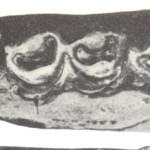 |
SHK II 1957.268 |
1114 |
19 - SHK |
|
L-MAN, L-P |
1957 |
104 - Unknown |
II |
|
|
Gentry, A. W., and Gentry, A. 1978. Fossil Bovidae (Mammalia) of Olduvai Gorge, Tanzania. Part I. Bulletin of the British Museum (Natural History): Geology 29:289-446. |
This specimen is pictured in plate 37, figure 1. |
137 - A. Gentry |
|
|
Unknown |
|
Mammalia |
Artiodactyla |
Ruminantia |
|
Bovoidea |
Bovidae |
Alcelaphinae |
Alcelaphini |
Indet. |
|
|
The authors suggest this specimen is "probably" Parmularius angusticornis or Damaliscus niro. It could also be from Connochaetes. |
No |
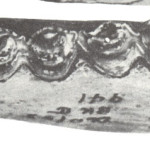 |
BK II 1963.941 |
1115 |
10 - BK |
|
MAN, L-M |
1963 |
104 - Unknown |
II |
|
|
Gentry, A. W., and Gentry, A. 1978. Fossil Bovidae (Mammalia) of Olduvai Gorge, Tanzania. Part I. Bulletin of the British Museum (Natural History): Geology 29:289-446. |
This specimen is pictured in plate 37, figure 2.� |
137 - A. Gentry |
|
|
Unknown |
|
Mammalia |
Artiodactyla |
Ruminantia |
|
Bovoidea |
Bovidae |
Alcelaphinae |
Alcelaphini |
|
|
|
The authors suggest this specimen is "probably" Parmularius angusticornis or Damaliscus niro. It could also be from Connochaetes. |
No |
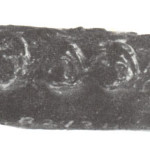 |
JK 2 III A. 2934 |
1117 |
46 - JK 2 |
|
R-MAN, R-M, R-P |
|
104 - Unknown |
III |
|
|
Gentry, A. W., and Gentry, A. 1978. Fossil Bovidae (Mammalia) of Olduvai Gorge, Tanzania. Part I. Bulletin of the British Museum (Natural History): Geology 29:289-446. |
This specimen is pictured in plate 37, figure 4. |
137 - A. Gentry |
|
|
Unknown |
|
Mammalia |
Artiodactyla |
Ruminantia |
|
Bovoidea |
Bovidae |
Alcelaphinae |
Alcelaphini |
Indet. |
|
|
The authors suggest this specimen is "probably" Parmularius angusticornis or Damaliscus niro. It could also be from Connochaetes. |
No |
|
JK2 III B. FFM4-9 |
813 |
46 - JK 2 |
|
L-M |
|
104 - Unknown |
III |
|
|
Gentry, A. W., and Gentry, A. 1978. Fossil Bovidae (Mammalia) of Olduvai Gorge, Tanzania. Part I. Bulletin of the British Museum (Natural History): Geology 29:289-446. |
|
137 - A. Gentry |
|
|
Unknown |
|
Mammalia |
Artiodactyla |
Ruminantia |
|
Bovoidea |
Bovidae |
Reduncinae |
Reduncini |
Kobus |
ellipsiprymnus |
|
The authors suggest this specimen could belong to a waterbuck. |
No |
|
FLK NN I 358 |
886 |
6 - FLK NN |
|
HUM |
|
104 - Unknown |
I |
|
|
Gentry, A. W., and Gentry, A. 1978. Fossil Bovidae (Mammalia) of Olduvai Gorge, Tanzania. Part I. Bulletin of the British Museum (Natural History): Geology 29:289-446. |
|
137 - A. Gentry |
|
|
Unknown |
|
Mammalia |
Artiodactyla |
Ruminantia |
|
Bovoidea |
Bovidae |
Alcelaphinae |
Alcelaphini |
Connochaetes |
sp. |
|
The authors suggest this specimen could be from Connochaetes, Megalotragus, or Beatragus. |
No |
|
FLK NN I 405 |
887 |
6 - FLK NN |
|
MTC |
|
104 - Unknown |
I |
|
|
Gentry, A. W., and Gentry, A. 1978. Fossil Bovidae (Mammalia) of Olduvai Gorge, Tanzania. Part I. Bulletin of the British Museum (Natural History): Geology 29:289-446. |
|
137 - A. Gentry |
|
|
Unknown |
|
Mammalia |
Artiodactyla |
Ruminantia |
|
Bovoidea |
Bovidae |
Alcelaphinae |
Alcelaphini |
Connochaetes |
sp. |
|
The authors suggest this specimen could be from Connochaetes, Megalotragus, or Beatragus. |
No |
|
FLK NN I 305 |
889 |
6 - FLK NN |
|
MTC |
|
104 - Unknown |
I |
|
|
Gentry, A. W., and Gentry, A. 1978. Fossil Bovidae (Mammalia) of Olduvai Gorge, Tanzania. Part I. Bulletin of the British Museum (Natural History): Geology 29:289-446. |
|
137 - A. Gentry |
|
|
Unknown |
|
Mammalia |
Artiodactyla |
Ruminantia |
|
Bovoidea |
Bovidae |
Alcelaphinae |
Alcelaphini |
Connochaetes |
sp. |
|
The authors suggest this specimen could be from Connochaetes, Megalotragus, or Beatragus. |
No |
|
FLK NN I 577+578 |
890 |
6 - FLK NN |
|
MTC, RAD |
|
|
I |
|
|
Gentry, A. W., and Gentry, A. 1978. Fossil Bovidae (Mammalia) of Olduvai Gorge, Tanzania. Part I. Bulletin of the British Museum (Natural History): Geology 29:289-446. |
|
137 - A. Gentry |
|
|
Unknown |
|
Mammalia |
Artiodactyla |
Ruminantia |
|
Bovoidea |
Bovidae |
Alcelaphinae |
Alcelaphini |
Connochaetes |
sp. |
|
The authors suggest this specimen could be from Connochaetes, Megalotragus, or Beatragus. |
No |
|
FLK N I 1728 |
943 |
7 - FLK North |
|
MAN |
|
104 - Unknown |
I |
|
|
Gentry, A. W., and Gentry, A. 1978. Fossil Bovidae (Mammalia) of Olduvai Gorge, Tanzania. Part I. Bulletin of the British Museum (Natural History): Geology 29:289-446. |
|
137 - A. Gentry |
|
|
Unknown |
|
Mammalia |
Artiodactyla |
Ruminantia |
|
Bovoidea |
Bovidae |
Alcelaphinae |
Alcelaphini |
Parmularius |
altidens |
|
The authors say this specimen is "probably" P. altidens. |
No |
|
DK I 067/4085 |
828 |
24 - DK |
|
R-M |
|
104 - Unknown |
I |
|
|
Gentry, A. W., and Gentry, A. 1978. Fossil Bovidae (Mammalia) of Olduvai Gorge, Tanzania. Part I. Bulletin of the British Museum (Natural History): Geology 29:289-446. |
|
137 - A. Gentry |
|
|
Unknown |
|
Mammalia |
Artiodactyla |
Ruminantia |
|
Bovoidea |
Bovidae |
Reduncinae |
Reduncini |
Redunca |
sp. |
|
The authors put this in Redunca sp. due to the small size. |
No |
|
FLK N I 067/185 |
829 |
7 - FLK North |
|
R-M |
|
104 - Unknown |
I |
|
|
Gentry, A. W., and Gentry, A. 1978. Fossil Bovidae (Mammalia) of Olduvai Gorge, Tanzania. Part I. Bulletin of the British Museum (Natural History): Geology 29:289-446. |
|
137 - A. Gentry |
|
|
Unknown |
|
Mammalia |
Artiodactyla |
Ruminantia |
|
Bovoidea |
Bovidae |
Reduncinae |
Reduncini |
Redunca |
sp. |
|
The authors put this in Redunca sp. due to the small size. |
No |
|
DK I 5400 |
722 |
24 - DK |
|
FEM |
|
104 - Unknown |
I |
|
|
Gentry, A. W., and Gentry, A. 1978. Fossil Bovidae (Mammalia) of Olduvai Gorge, Tanzania. Part I. Bulletin of the British Museum (Natural History): Geology 29:289-446. |
|
137 - A. Gentry |
|
|
Unknown |
|
Mammalia |
Artiodactyla |
Ruminantia |
|
Bovoidea |
Bovidae |
Bovinae |
Tragelaphini |
|
|
|
The authors describe this specimen as coming from a "larger tragelaphine". |
No |
|
FLK I G. 258 |
723 |
5 - FLK |
|
MTC |
|
104 - Unknown |
I |
|
|
Gentry, A. W., and Gentry, A. 1978. Fossil Bovidae (Mammalia) of Olduvai Gorge, Tanzania. Part I. Bulletin of the British Museum (Natural History): Geology 29:289-446. |
|
137 - A. Gentry |
|
|
Unknown |
|
Mammalia |
Artiodactyla |
Ruminantia |
|
Bovoidea |
Bovidae |
Bovinae |
Tragelaphini |
|
|
|
The authors describe this specimen as coming from a "larger tragelaphine". |
No |
|
OVPP-Syncerus 3 |
767 |
10 - BK |
|
M?, I?, P? |
|
104 - Unknown |
II |
|
|
Gentry, A. W., and Gentry, A. 1978. Fossil Bovidae (Mammalia) of Olduvai Gorge, Tanzania. Part I. Bulletin of the British Museum (Natural History): Geology 29:289-446. |
The authors discuss teeth found at BK II but does not specifically describe which type(s) of teeth are found. |
137 - A. Gentry |
|
|
Unknown |
|
Mammalia |
Artiodactyla |
Ruminantia |
|
Bovoidea |
Bovidae |
Bovinae |
Bovini |
Syncerus |
acoelotus |
|
The authors describe these specimens as being smaller than P. oldowayensis. |
No |
|
OVPP-Syncerus 2 |
766 |
46 - JK 2 |
|
M?, I?, P? |
|
104 - Unknown |
III |
|
|
Gentry, A. W., and Gentry, A. 1978. Fossil Bovidae (Mammalia) of Olduvai Gorge, Tanzania. Part I. Bulletin of the British Museum (Natural History): Geology 29:289-446. |
|
137 - A. Gentry |
|
|
Unknown |
|
Mammalia |
Artiodactyla |
Ruminantia |
|
Bovoidea |
Bovidae |
Bovinae |
Bovini |
Syncerus |
acoelotus |
|
The authors describe teeth but not specifically which type(s) of teeth that are more likely to be from S. acoelotus than P. antiquus. |
No |
|
F173 |
3016 |
6 - FLK NN |
|
LIMB, ENPS |
|
105 - National Museum and House of Culture, Dar es Salaam, Tanzania (?) |
I |
|
|
Auffenberg, W. 1981. The fossil turtles of Olduvai Gorge, Tanzania, Africa. Copeia 1981:509-522. |
Original information indicated that this specimen was located in Nairobi. This specimen is likely within the material that was repatriated to Dar in 2011, but this has yet to be confirmed. |
152 - W. Auffenberg |
|
264 - Leakey family expedition |
Unknown |
|
Reptilia |
Testudines |
|
|
|
|
|
|
|
|
|
The author mentions there are over 3,000 fossilized turtle fragments from Olduvai Gorge, 98% of which are from the species Pelusios sinuatus. However, it is unclear which specimens belong to which species based on the description given. When it was unclear, the specimen is only referred to as belonging to the Order Testudines. |
No |
|
F490 |
3028 |
6 - FLK NN |
|
CARA-f, LIMB, PLAS-f |
|
105 - National Museum and House of Culture, Dar es Salaam, Tanzania (?) |
I |
|
|
Auffenberg, W. 1981. The fossil turtles of Olduvai Gorge, Tanzania, Africa. Copeia 1981:509-522. |
Original information indicated that this specimen was located in Nairobi. This specimen is likely within the material that was repatriated to Dar in 2011, but this has yet to be confirmed. |
152 - W. Auffenberg |
|
264 - Leakey family expedition |
Unknown |
|
Reptilia |
Testudines |
|
|
|
|
|
|
|
|
|
The author mentions there are over 3,000 fossilized turtle fragments from Olduvai Gorge, 98% of which are from the species Pelusios sinuatus. However, it is unclear which specimens belong to which species based on the description given. When it was unclear, the specimen is only referred to as belonging to the Order Testudines. |
No |
|
F4722 |
3037 |
6 - FLK NN |
|
LIMB, NRL |
|
105 - National Museum and House of Culture, Dar es Salaam, Tanzania (?) |
I |
|
|
Auffenberg, W. 1981. The fossil turtles of Olduvai Gorge, Tanzania, Africa. Copeia 1981:509-522. |
Original information indicated that this specimen was located in Nairobi. This specimen is likely within the material that was repatriated to Dar in 2011, but this has yet to be confirmed. |
152 - W. Auffenberg |
|
264 - Leakey family expedition |
Unknown |
|
Reptilia |
Testudines |
|
|
|
|
|
|
|
|
|
The author mentions there are over 3,000 fossilized turtle fragments from Olduvai Gorge, 98% of which are from the species Pelusios sinuatus. However, it is unclear which specimens belong to which species based on the description given. When it was unclear, the specimen is only referred to as belonging to the Order Testudines. |
No |
|
F4725 |
3040 |
6 - FLK NN |
|
LIMB-f |
|
105 - National Museum and House of Culture, Dar es Salaam, Tanzania (?) |
I |
|
|
Auffenberg, W. 1981. The fossil turtles of Olduvai Gorge, Tanzania, Africa. Copeia 1981:509-522. |
Original information indicated that this specimen was located in Nairobi. This specimen is likely within the material that was repatriated to Dar in 2011, but this has yet to be confirmed. |
152 - W. Auffenberg |
|
264 - Leakey family expedition |
Unknown |
|
Reptilia |
Testudines |
|
|
|
|
|
|
|
|
|
The author mentions there are over 3,000 fossilized turtle fragments from Olduvai Gorge, 98% of which are from the species Pelusios sinuatus. However, it is unclear which specimens belong to which species based on the description given. When it was unclear, the specimen is only referred to as belonging to the Order Testudines. |
No |
|
F4726 |
3041 |
6 - FLK NN |
|
LIMB, PVG, PCG |
|
105 - National Museum and House of Culture, Dar es Salaam, Tanzania (?) |
I |
|
|
Auffenberg, W. 1981. The fossil turtles of Olduvai Gorge, Tanzania, Africa. Copeia 1981:509-522. |
Original information indicated that this specimen was located in Nairobi. This specimen is likely within the material that was repatriated to Dar in 2011, but this has yet to be confirmed. |
152 - W. Auffenberg |
|
264 - Leakey family expedition |
Unknown |
|
Reptilia |
Testudines |
|
|
|
|
|
|
|
|
|
The author mentions there are over 3,000 fossilized turtle fragments from Olduvai Gorge, 98% of which are from the species Pelusios sinuatus. However, it is unclear which specimens belong to which species based on the description given. When it was unclear, the specimen is only referred to as belonging to the Order Testudines. |
No |
|
OVPP-Herpestes 1 |
71 |
7 - FLK North |
|
M |
|
104 - Unknown |
I |
upper |
3 |
Leakey LSB. 1965. Olduvai Gorge 1951-1961, Volume 1: Fauna and Background. New York, NY: Cambridge University Press. |
|
130 - L.S.B. Leakey |
|
264 - Leakey family expedition |
Yes |
|
Mammalia |
Carnivora |
Feliformia |
|
|
Herpestidae |
Herpestinae |
|
Herpestes |
sp. |
|
The author mentions 4 other teeth found with this specimen but is not sure of their taxonomy. |
No |
|
OVPP-Muridae 4 |
40 |
7 - FLK North |
|
P, M, I, C |
|
104 - Unknown |
I |
upper |
1, 2, 3, 4, 5, 6 |
Leakey LSB. 1965. Olduvai Gorge 1951-1961, Volume 1: Fauna and Background. New York, NY: Cambridge University Press. |
Several specimens of unidentified murids are present. |
130 - L.S.B. Leakey |
|
264 - Leakey family expedition |
Unknown |
|
Mammalia |
Rodentia |
Myomorpha |
Myodonta |
Muroidea |
Muridae |
|
|
|
|
|
The author is unsure of the taxonomy. |
No |
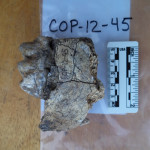 |
COP-12-45 |
9630 |
|
|
L-MAN-f, L-M |
|
126 - Mary Leakey Camp, Antiquities Station Olduvai Gorge, Tanzania |
|
|
|
-- |
Left mandibular fragment with M3. Stratigraphy unknown. |
157 - L. Hlusko |
2013/06/21 |
254 - COP |
Unknown |
Y |
Mammalia |
Artiodactyla |
Suiformes |
|
Hippopotamoidea |
Hippopotamidae |
|
|
|
|
|
Small |
No |
|
OH 34 |
3749 |
76 - JK W |
|
FEM
, TIB-f |
1962 |
122 - National Museum and House of Culture, Dar es Salaam, Tanzania |
III/ IV |
for Bed IV level = a |
|
Leakey MD. (1971) Olduvai Gorge, Vol. 3: excavations in Beds I & II 1960-1963. New York, NY: Cambridge University Press. |
Femur described as "slender" (Leakey MD, 1971) and shaft of tibia. Specimen previously housed at National Museum of Kenya. |
|
|
264 - Leakey family expedition |
Yes |
|
Mammalia |
Primates |
Anthropoidea |
Haplorhini |
Hominoidea |
Hominidae |
Homininae |
Hominini |
Homo |
sp. |
|
Slender bone |
No |
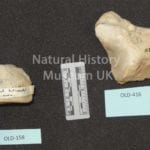 |
OLD-158 |
12449 |
|
|
HAM |
|
114 - Natural History Museum UK |
|
|
|
-- |
OLD-158; hamate/unciform/uncinate |
|
|
|
Unknown |
|
Mammalia |
Artiodactyla |
|
|
|
|
|
|
|
|
|
ruminant Artiodactyl |
No |
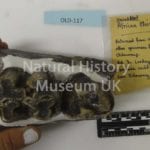 |
OLD-117 |
12407 |
|
|
MAX-f with teeth |
|
114 - Natural History Museum UK |
|
|
|
-- |
OLD-117; based on note with specimen, may not be from Olduvai |
|
|
|
Unknown |
|
Mammalia |
|
|
|
|
|
|
|
|
|
|
Rhino or Hippo |
Yes |
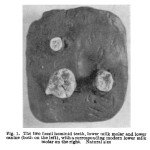 |
OH 3 |
3719 |
10 - BK |
280 - 94 |
d-C
, L-d-M |
1955 |
122 - National Museum and House of Culture, Dar es Salaam, Tanzania |
II |
Upper |
Upper part of BK channel which cuts into Tuff IID |
Leakey MD. (1971) Olduvai Gorge, Vol. 3: excavations in Beds I & II 1960-1963. New York, NY: Cambridge University Press. |
In the first publication of these specimens (Leakey, LSB, 1958), Leakey described the teeth as a deciduous lower canine and a left deciduous upper M2. "This view was not shared by Robinson, von Koenigswald and others, who preferred to regard it as either a permanent or a deciduous upper molar of an australopithecine character" (Leakey, MD, 1970:226). Specimen previously housed at National Museum of Kenya. |
130 - L.S.B. Leakey |
|
264 - Leakey family expedition |
Yes |
|
Mammalia |
Primates |
Anthropoidea |
Haplorhini |
Hominoidea |
Hominidae |
|
|
Australopithecus |
|
|
Referred to as species boisei in Tobias (Olduvai Gorge volume IV, 1991). |
No |
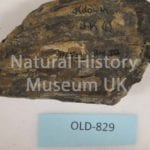 |
OLD-829 |
12921 |
40 - JK |
|
R-M-f |
|
114 - Natural History Museum UK |
III |
|
|
-- |
OLD-829; distal fragment of right upper M3 |
|
|
|
Unknown |
|
Mammalia |
Artiodactyla |
Suiformes |
|
Suoidea |
Suidae |
Suinae |
Phacochoerini |
Metridiochoerus |
|
|
previous taxonomic ID: Tapinochoerus meadowsi |
No |
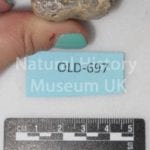 |
OLD-697 |
12805 |
317 - MRK S |
|
L-M-f |
|
114 - Natural History Museum UK |
II |
|
|
-- |
OLD-697; left mesial fragment of upper M3; MRK IIS 21.5.35 |
|
|
|
Unknown |
|
Mammalia |
Artiodactyla |
Suiformes |
|
Suoidea |
Suidae |
Suinae |
Phacochoerini |
Metridiochoerus |
|
|
previous taxonomic ID Tapinochoerus meadowsi |
No |
|
M. 14683 |
10383 |
|
|
Two upper tusks, probably of the same individual. |
1934 |
106 - Natural History Museum UK (?) |
I |
lower part, Middle Pleistocene |
Kamasian Pluvial |
LSB Leakey. 1958. Fossil Mammals of Africa: Some East African Pleistocene Suidae. British Museum. No. 14. |
British Museum Palaeontology Department |
130 - L.S.B. Leakey |
1942 |
|
Unknown |
|
Mammalia |
Artiodactyla |
Suiformes |
|
Suoidea |
Suidae |
|
|
Potamochoerus |
majus |
|
Paratypes. Originally classified as Koiropotamus majus (Hopwood, 1934). Reclassified as Potamochoerus majus (Leakey, 1942). |
Yes |
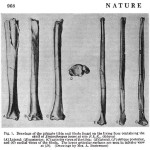 |
OH 6 |
3721 |
5 - FLK |
283 - 45 |
CRA-f
, M-f
, L-P
, L-TIB-f
, L-FIB-f
, |
1959/60 |
122 - National Museum and House of Culture, Dar es Salaam, Tanzania |
I |
Middle (Zinj.) |
Surface. Cranial and dental fragments found in surface soil from slope immediately below Zinj. site; assumed to be from Zinj. level (Leakey, MD, 1971:227). TIB-f and FIB-f from Zinj. level. |
Davis, P. R. 1964. Hominid fossils from Bed I, Olduvai Gorge, Tanganyika. A tibia and fibula. Nature. 201, 967. |
From Tobias (1991): OH 35 tibia and fibula attributed to same individual as OH 6 but appear to be more mature. It is unclear if OH 35 tibia and fibula are the same tibia and fibula originally listed under OH 6. Leakey, MD, 1971 describes CRA and dental fragments as having been found in surface soil, but Leakey, Tobias, and Napier, 1964 state "some [were] found in situ [and] some on the surface" (:9). Unworn lower L-P3. Partially developed roots of upper M1 or 2. Six cranial vault fragments. Tibia and fibula fragments first assumed to be associated with Zinjanthropus OH5, but should be considered associates with OH 6 following morphological study (Leakey, MD, 1971:227). and skull fragments. Juvenile. Specimen previously housed at National Museum of Kenya. |
|
|
264 - Leakey family expedition |
Unknown |
|
Mammalia |
Primates |
Anthropoidea |
Haplorhini |
Hominoidea |
Hominidae |
Homininae |
Hominini |
Homo |
habilis |
|
Paratype. TIB-f and FIB-f not given taxonomic designation in original publication (Davis, 1964) but named as a paratype in Leakey, Tobias, and Napier, 1964. |
No |
|
M. 14685 |
1347 |
|
|
L-MAN-f, L-M |
|
106 - Natural History Museum UK (?) |
II |
|
|
Hopwood, A. 1934. New fossil mammals from Olduvai, Tanganyika territory. Annals of the Magazine of Natural History. 10: 546-550. |
|
293 - A.T. Hopwood |
|
|
Unknown |
|
Mammalia |
Artiodactyla |
Suiformes |
|
Suoidea |
Suidae |
Tetraconodontinae |
|
Notochoerus |
dietrichi |
|
Paratype-�This specimen was referred to as the holotype by Bishop (2010). Bishop also reclassified this sepcimen as Metridiochoerus hopwoodi. |
No |
|
M. 14686 |
1349 |
|
|
R-MAN, R-P, R-M |
|
106 - Natural History Museum UK (?) |
II |
|
|
Hopwood, A. 1934. New fossil mammals from Olduvai, Tanganyika territory. Annals of the Magazine of Natural History. 10: 546-550. |
The author suggests this specimen is "probably" from Bed II. |
293 - A.T. Hopwood |
|
|
Unknown |
|
Mammalia |
Artiodactyla |
Ruminantia |
|
Giraffoidea |
Giraffidae |
|
|
Helladotherium |
olduvaiensis |
|
Paratype |
No |
|
M. 14687 |
1350 |
|
|
TIB-f, FEM-f, FIB-f |
|
106 - Natural History Museum UK (?) |
I |
|
|
Hopwood, A. 1934. New fossil mammals from Olduvai, Tanganyika territory. Annals of the Magazine of Natural History. 10: 546-550. |
This specimen is described as a "partial hind-limb". Whether it is a tibia, femur, or fibula is unknown. |
293 - A.T. Hopwood |
|
|
Unknown |
|
Mammalia |
Artiodactyla |
Ruminantia |
|
Giraffoidea |
Giraffidae |
|
|
Helladotherium |
olduvaiensis |
|
Paratype |
No |
|
OLD 1960 F200 |
3714 |
5 - FLK |
|
R-MAN-f, d-P, M |
1960 |
105 - National Museum and House of Culture, Dar es Salaam, Tanzania (?) |
I |
|
|
Harris, J. M., Solounias, N., and Geraads, D. 2010. Giraffoidea. Werdelin, L., Sanders, W. J., eds. In: Cenozoic Mammals of Africa. London: University of California Press. pp. 393-428. |
Original information indicated that this specimen was located in Nairobi. This specimen is likely within the material that was repatriated to Dar in 2011, but this has yet to be confirmed. |
155 - Harris, Solounias, and Geraads |
|
264 - Leakey family expedition |
Unknown |
|
Mammalia |
Artiodactyla |
Ruminantia |
|
Giraffoidea |
Giraffidae |
Giraffinae |
Giraffini |
Giraffa |
pygmaea |
|
Paratype |
No |
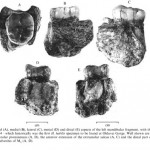 |
OH 4 |
3720 |
8 - MK |
281 - 11 |
P
, M
, MAN |
1959 |
122 - National Museum and House of Culture, Dar es Salaam, Tanzania |
I |
Lower |
Surface. |
Leakey, L.S.B., Tobias, P.V. & Napier, J.R. 1964. A new species of the genus Homo from Olduvai Gorge. Nature 202(4927): 7-9. |
Paratype. Two isolated teeth (lower molar and upper premolar) and one M3 in a mandible. Found in small block of consolidated tuff. �Specimen previously housed at National Museum of Kenya. |
282 - H. Mukiri |
|
264 - Leakey family expedition |
Yes |
|
Mammalia |
Primates |
Anthropoidea |
Haplorhini |
Hominoidea |
Hominidae |
Homininae |
Hominini |
Homo |
habilis |
|
Paratype |
No |
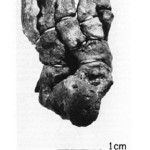 |
OH 8 |
3723 |
6 - FLK NN |
283 - 45 |
PHX
, CAR
, TAR
, CLA
, AST
, CAL
, CUNE
, CUB
, NAV
, M-f |
1960 |
122 - National Museum and House of Culture, Dar es Salaam, Tanzania |
I |
3 |
|
Leakey MD. (1971) Olduvai Gorge, Vol. 3: excavations in Beds I & II 1960-1963. New York, NY: Cambridge University Press. |
The molar-f was found on the surface and "probably also belongs to OH 8" (Leakey MD, 1971:228). Twelve associated foot bones including astragalus (has carnivore tooth marks (Leakey MD, 1971), calcaneus, cuboid and navicular, cuneiforms 1- 3, proximal ends with shafts, five metatarsals. Proximal ends of one metacarpal and three finger phalanges. One radius shaft. Clavicle with damaged articular ends. Foot articulates "almost perfectly with the OH 35 leg" (Susman, 1983:372). |
130 - L.S.B. Leakey |
|
264 - Leakey family expedition |
Yes |
|
Mammalia |
Primates |
Anthropoidea |
Haplorhini |
Hominoidea |
Hominidae |
Homininae |
Hominini |
Homo |
habilis |
|
Paratype |
No |
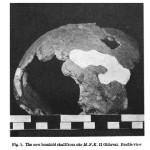 |
OH 13 |
3728 |
27 - MNK |
287 - 88 "Skull Site" |
MAN
, MAX
, CRA-f |
1963 |
122 - National Museum and House of Culture, Dar es Salaam, Tanzania |
II |
Lower Middle IIB |
5 feet above chert horizon |
|
Paratpye. "This consists of a sub-adult skull, probably female, with the third molars coming into wear. It is represented by the greater part of the mandible, including the complete dentition, although the crowns of the incisors are damaged and the left ascending ram us is not preserved; the greater part of the maxillae, represented by two fragments both lacking the anterior portions; the greater part of the occipital; the right parietal and temporal; parts of the left parietal and temporal; together with a few frontal fragments and approximately fifty additional pieces which it has not been possible to fit together" (Leakey MD, 1971:231). Specimen previously housed at National Museum of Kenya. 5 pieces found at House of Culture, Dar es Salaam, Tanzania. |
130 - L.S.B. Leakey |
|
264 - Leakey family expedition |
Yes |
|
Mammalia |
Primates |
Anthropoidea |
Haplorhini |
Hominoidea |
Hominidae |
Homininae |
Hominini |
Homo |
habilis |
|
Paratype |
No |
|
OVPP-Erinaceus 94 |
1944 |
7 - FLK North |
|
MAX-f, P, M |
|
104 - Unknown |
I |
upper |
3 |
Butler, P., and Greenwood, M. 1973. The early Pleistocene hedgehogs from Olduvai, Tanzania. Fossil vertebrates of Africa 3:7-42. |
|
150 - Butler and Greenwood |
|
|
Unknown |
|
Mammalia |
Lipotyphya |
|
|
Erinaceoidea |
Erinaceidae |
Erinaceinae |
|
Erinaceus |
broomi |
|
Order has more recently been determined as Insectivora |
No |
|
OVPP-Soricidae 3 |
3853 |
24 - DK |
|
MAN |
|
|
I |
1 |
|
Butler, P., and Greenwood, M. 1979. Soricidae (Mammalia) from the Early Pleistocene of Olduvai Gorge, Tanzania. Zoological Journal of the Linnean Society 67:329-379. |
Broken left mandible with some worn teeth. |
150 - Butler and Greenwood |
|
|
Unknown |
|
Mammalia |
Insectivora |
|
|
Soricoidea |
Soricidae |
|
|
|
|
|
One of five specimens of indeterminant species of Soricidae from Olduvai. Authors state that there appears to be three different species represented in the indeterminant specimens. This specimen is described as Species III. |
No |












